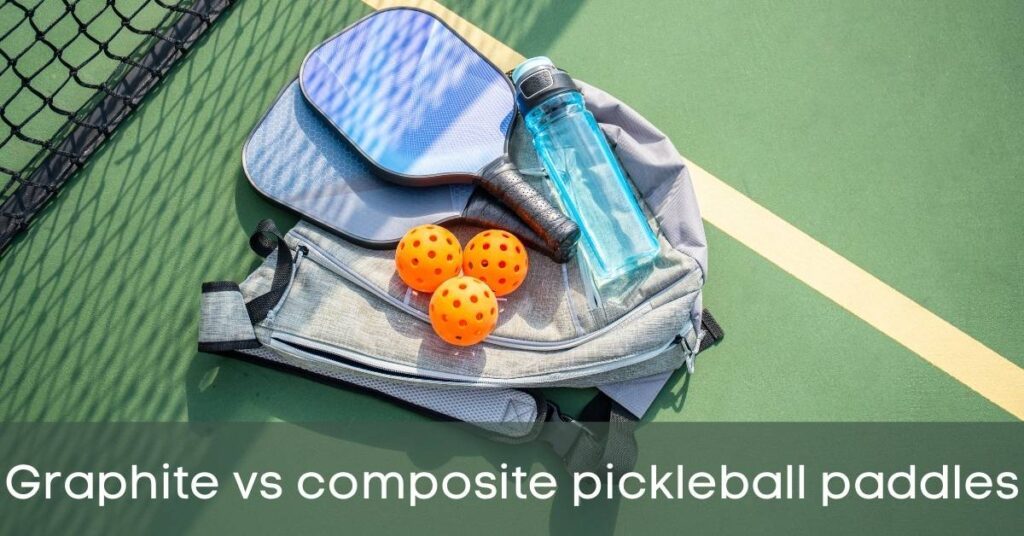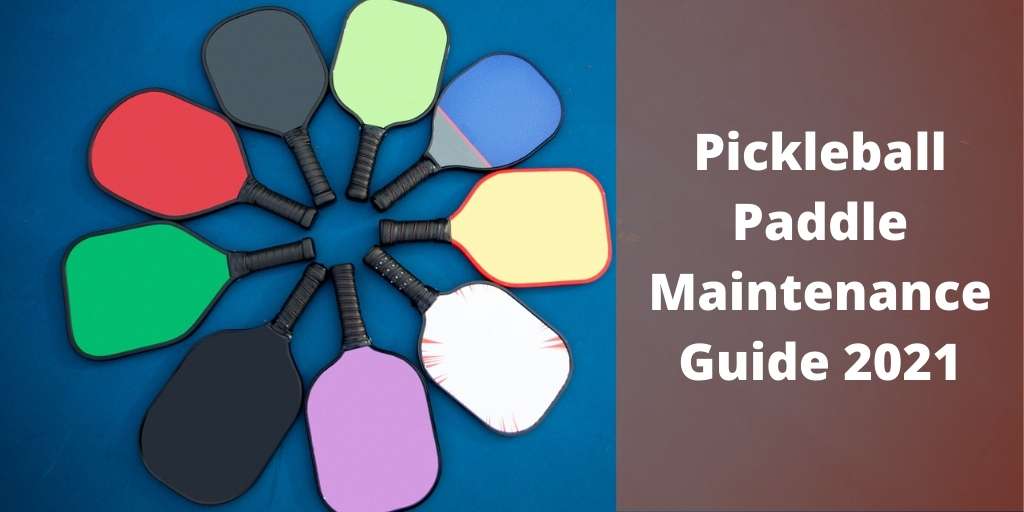It is crucial to select the right grip size of pickleball paddles to get optimal comfort. Having the right grip size can make a big difference in the paddle performance. The way we hold the paddle matters the way we play, and our goal is to hold the paddle in a way that complements our best strokes.
Before jumping to pick a pickleball paddle grip, you want to consider some essential factors like the type of grip, handle pattern, and measurement of your palm.
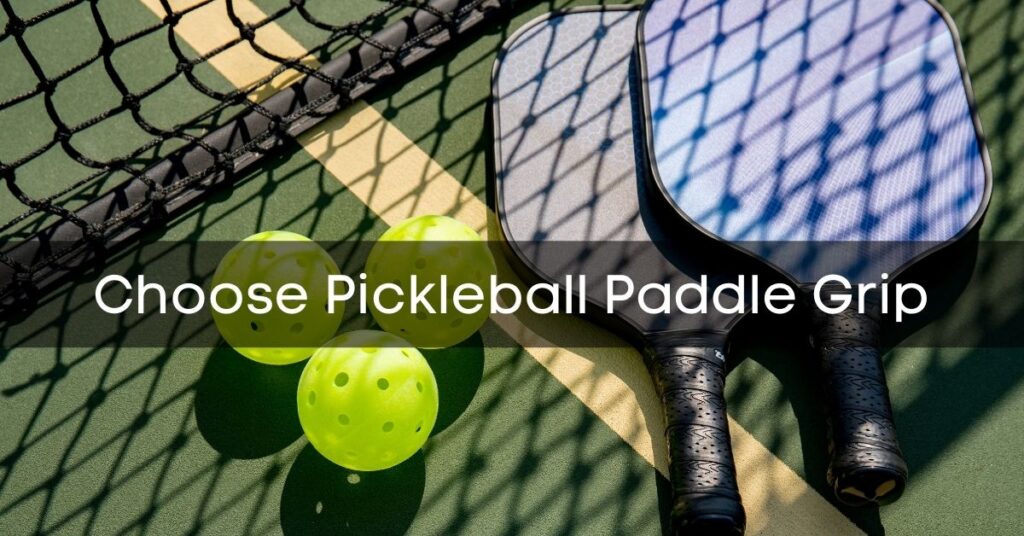
You want to choose neither a too small nor too large grip. Selecting an inappropriate grip will not allow you to control the pickleball paddle effectively. Or, you will need to put excessive efforts to control it. You may end up slipping it out of your hand.
How to Choose a Pickleball Paddle Grip Size?
Like tennis racquet grip size, three simple ways are available to choose grip size for pickleball paddle.
Natural Grip
You can choose your pickleball paddles grip size using a natural grip technique. First of all, take the paddle in your hand to conveniently fit your forefinger from the other hand. If no space left after holding it firmly, it is kind of a small size.
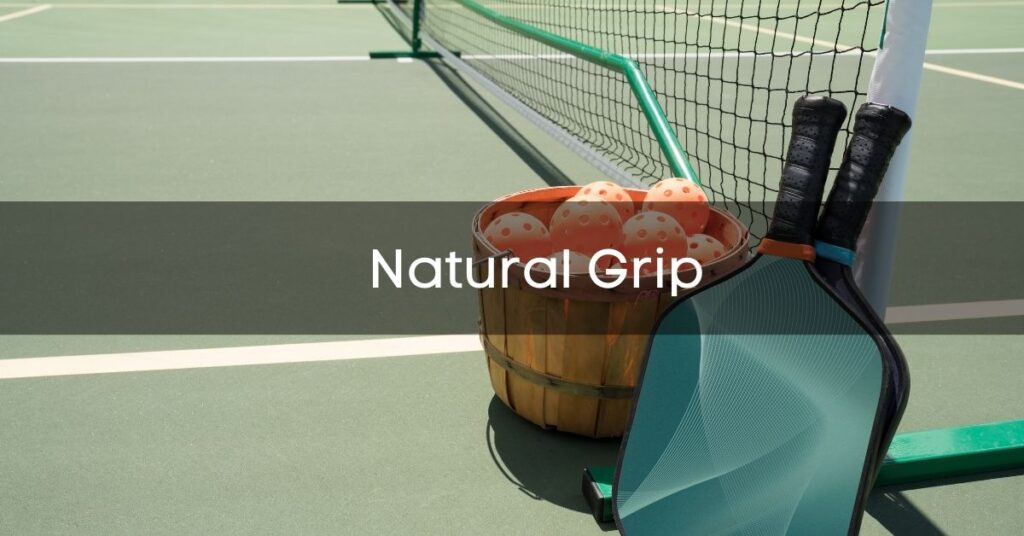
On the contrary, if you notice any additional space between the rounded pad at the bottom of your palm and fingers, it is kind of a large size. However, when you have only these two options, it is preferable to select the smaller size.
Index Finger Test
The second method is holding your preferred pickleball paddle-like Eastern grip style. Eastern grip is a way to keep the racket vertically to the ground and as if you are shaking hands with the grip.
Anatomically you can move your wrist freely, making it useful to hit strongly. If you get used to the eastern grip, you will use both the front and backside of the pickleball paddle at your will, thus making this grip very efficient.
After implementing the eastern grip, you want to put the forefinger of your other hand to slide it in-between your third finger and palm. You will find the perfect grip size when your first finger fits comfortably within this gap. It will neither leave too little nor too much space.
Once you have positioned your fingers to fit the grip size snugly, try to repeat the test several times to become 100% sure about it. Since it is a science-based approach, you should try to a couple of times.
It will provide accurate results to confirm you the process you are following is correct. Finally, you will feel relaxed once you find the perfect grip size.
Ruler Test
The third method for pickleball paddle grip size is called the ruler test or tape measure test. The process is simple and straightforward since all you need to put the ruler or tape measure on your hand to get the measurement.
First of all, make sure to keep your hand fully open at a flat position. Then, take the ruler or tape measure and hold it at a flat position close to your third finger. An individual’s grip size is the length between the roof of the third finger and the bottom lateral crease of your palm.
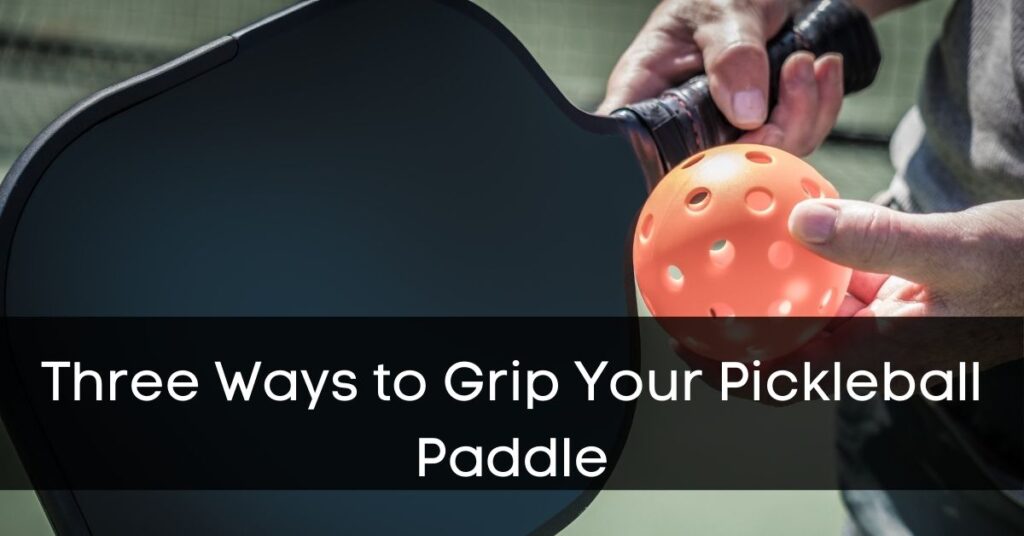
Three Ways to Grip Your Pickleball Paddle
There are three main elements that go into your grip: your pickleball paddle, the base of your index knuckle, and the center of your heel pad.
These three factors are going to determine what grip you have, along with some small variation in the position of your fingers. Generally, there are three ways to hold the paddle.
Hammer or Continental Grip
If you are crossing over to pickleball from another racket sport, you are probably used to using different grips because you can hit extra spins with forehands and backhands. One of the beauties that pickleball allows you to use one grip to hit every shot is the hammer or continental grip.
Hammer or continental grip means holding your paddle grip like imagining it’s a hammer striking in a nail. You will grab the paddle and shake hands with it.
This type of grip supports your hands when a part of a finger at a joint is confronting the net. The continental grip offers several advantages, like allowing you to play both forehand and back in evenly.
Plus, if you do this grip, you are free to implement this style for most of the playing techniques you want. You can maximize power on all shots because it is very flat.
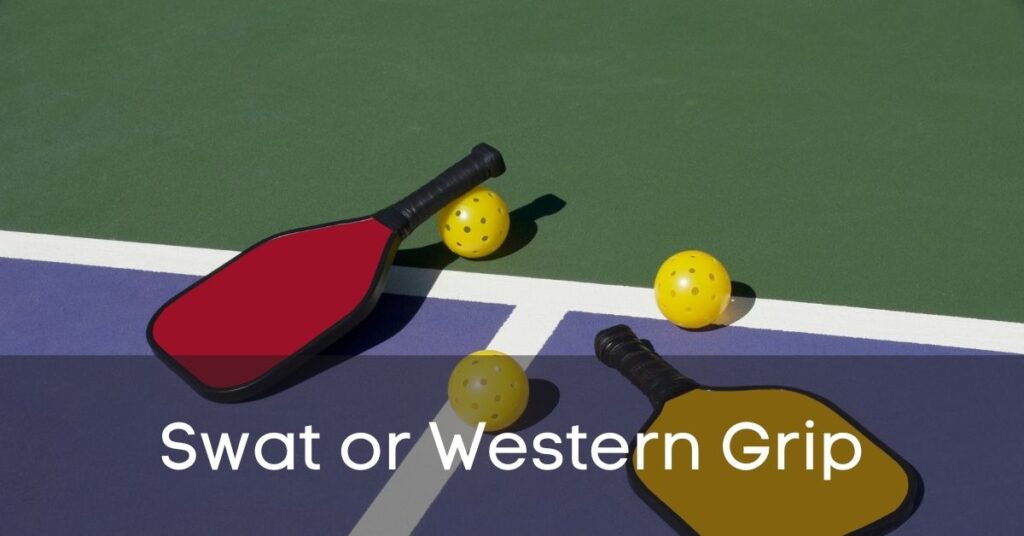
Swat or Western Grip
Swat or western grip is top-favorite among beginners, and they instinctively pick up a paddle to play pickleball, especially they are new to paddle sports.
Also, for forehand strokes, you get impressive comfort when a stroke is performed with the palm of the hand opposites along the stroke’s right line. In tennis, people call it the western or semi-western grip.
When your index finger base is located on the handle of the paddle, it is called a semi-western grip. If your pointer finger touches the paddle from top to bottom of the handle, we define it as a fully western grip.
However, it is an excellent grip for a four-handed game. But it will be a challenging task when you want to play the ball with your paddle with your upper limbs throughout the body while the palm of your hand fronts the ball.
People who want to accomplish backhand stroke in a powerful manner will execute two-handed backhand whether they are using a semi-western or fully western grip. Another effective solution you can use by taking the paddle in the left hand rather than striking in backends.
Eastern Grip
Eastern Grip is one of the most well-known grips, and it seems like handshaking with the paddle. If you want to use an eastern grip, you will make a settlement between backhand and forehand. It is an ideal alternative grip for a pickleball game.
Your index knuckle and your heel pad will both be on the third level for the traditional eastern grip. And, for the semi-western grip, your whole hand will rotate around one bevel. As a result, your knuckle and heel pad are both on the fourth level.
Most players use a semi-western grip instead of a fully western grip because both your index knuckle and the heel pad are going to be on the fourth level.
When you hold your arms straight out, you can see this naturally turns the paddle face down towards the ground. It makes returning balls at chest height or above much more comfortable, and it is one of the biggest reasons why most pros use this grip.
At the pro level, especially on the men’s side, they’re playing within such spin that the majority of the balls actually need to be made at a specific contact point. So, the semi-western grip allows them to maintain more leverage in the hitting arm when the ball is high.
Most professionals use a slightly modified semi-western grip with their heel pad, not on the fourth level but somewhere in between the third and fourth level.
How To Replace A Pickleball Paddle Grip
You might know many parts of pickleball paddle is similar to tennis. Replacing pickleball paddle grip is a common thing for professionals, and they do it regularly to get the perfect grip for maximum comfort. However, not everyone knows how to replace a pickleball paddle grip correctly.
You want to make sure your paddle grip is neat & clean and maintain its good condition. Unless your paddle grip retains its high quality, you can’t focus all your attention on your game.
As a professional or regular player, your paddle grip will start to wear and tear after one or a few months. When your paddle grip supports you the best way, you start focusing and improving your skills and boosting performance.
Replacing or over-gripping your pickleball paddle is uncomplicated. However, for beginners, it may take few times to become familiar with the whole process.
When Should You Change Your Grip?
Many uncomfortable conditions may pop-up to notify you that it’s time to replace your pickleball paddle grip. Some common occurring is given below:
- No tacky feeling while holding the grip.
- If you already played more than 150 hours using the same grip, you might want to change it. However, preference and needs may go up and down from player to player due to individual playing styles.
- You may experience slippery hands, and your paddle moves toward the bottom level while holding it. However, it may also happen because of a small grip.
- You hold the paddle typically, and it is thrown away from your hand accidentally without your control.
- You just want to get the most powerful grip by changing the old grip.
There is nothing wrong with gripping your paddle because the tacky grip lasts only for a few months or 100-150 hours of total playtime. You can either change the whole grip or over-grip it. Many professionals prefer to do over-gripping to thicken the grip slightly while getting back the tackiness.
As a result, you don’t need to change the whole grip, and it will save your time and effort. Here, we are mentioning both methods so that you can follow any of them if you feel like doing it.
Step-by-step Guide To Changing Your Paddle Grip
Instead of purchasing one grip, it is better to choose two regrips because you might mess up while setting up the grip. But there is nothing wrong with messing up since you can remove the regrip and repeat the setup process.
Step 1 — Keep Everything Ready You Need for Grip Setup
Before setting up the new grip, you want to make sure you have already kept ready everything you need.
- A kitchen scissor.
- A good-quality grip.
- Your calmness and concentration.
You may feel restless while replacing the grip for the first occasion. Many brands are available for replacement grip like Gamma, ProLite, or so forth. No matter what type of grip you choose, most of them have a half-inch electrical tape band.
And, you will notice the brand name at the top of the grip package. Just remove the brand from the grip and keep it aside on your table or whatever. You will notice the electrical tape and the grip finally inside it.
Step 2 — Take Off The Old Grip
It is time to remove the old grip, which does not give the type of support you want. First of all, you will need to take off the electrical tape from the outside of the handle. Make sure to flake off all the tape from the handle, and you may notice some leavings from the spot.
After peeling off all the electrical tape, it will look sticky and a little bit messy.
Step 3 — Following Simple Method
Here comes the most exciting part. To make your gripping task simple and straightforward, we will follow a simple workflow. There are two sides to your electrical tape: one side has sticky gum, and the other side is free from the gum.
Now, you will roll over the sticky gum side on your paddle handle. Start sticking the tape from the top of the handle to the bottom of the handle. Make sure to roll over the tape tightly to cover every tiny spot. Don’t worry about running out of tape because the manufacturing company provides sufficient cover to cover everything completely well.
The success of applying grip depends on how you stick it on the handle and whether you lay it in the perfect position. You will never stick the tape loosely since it will become loose automatically after few hours of playing time.
So, apply the tape as firmly and tightly as possible without overdoing it. It will make your gripping task more manageable and hassle-free.
Step 4 — Grip Up The Whole Handle
After applying the grip tape, it is time to stick to the real grip. Like the grip tape, we will follow a diagonally upward direction to apply the grip. It makes the grip comfortable without having any uneven surface. If you notice any uneven surface, loosen the grip and repeat the process carefully to make it perfect.
What is more crucial than other things is maintaining the right angle. When you wrap the grip in a sequence manner from bottom to top, you will have perforated holes on the handle. You can make imaginary lines on your mind and apply the grip based on it.
One essential thing you must not forget is uncovering the holes of the grip. It will absorb moisture, which produces from your sweaty hands.
Like the grip tape, you also want to wrap the grip tightly to ensure a precise setup. And, if you can do it successfully with the correct angle, you have accomplished the core task. However, you will never wrap it too tight manner that it is stretching the grip.
Step 5— Cut the Grip and Take It Off
Then, you need to separate the extra grip left from the roof of the handle. You can use a kitchen scissors to cut it off. Before cutting the grip, you want to provide yourself sufficient room to cut.
If you cut from the starting point of leftover, you will not be able to wrap it up. That’s why save some leftovers like 1-1.5-inch to properly wrap the grip after cutting it. Once you are finished cutting the grip, wrap the grip immediately and tightly. Now, you have completed all the steps. Done!
How to Do Over-gripping without Changing the Whole Grip
Replacing the whole grip is not compulsory when you want only additional tackiness. Over-gripping is the process of gripping on the existed grip of your paddle handle. In fact, many professional players prefer to do it instead of changing the grip.
Different brands offer different colors to make gripping tasks fun. You are free to choose any color as long as the grip has high-quality materials to ensure thickness and comfort. Whether you want to change the whole grip or over-grip of your handle, you need to follow almost the same process that we have already mentioned.
In fact, it is more easygoing since it takes less time and effort to do the task successfully. Also, if you make any mistake, you can loosen the grip and do it again correctly.
Since both processes are the same, we will not mention them step by step. Over-gripping will not allow you to grip your handle as tightly as you can do for changing the entire grip. Thankfully, manufacturing companies make the over-gripping tape more flexible than the regular grip.
Hence, you are free to wrap the grip tape in more tightly, unlike standard grips. It is one of the essential parts as you never wish for accidental bulges sticking out of your handle.
Wrap up the grips properly with the correct angle, as we mentioned above. You may don’t need to cut the grip since the over-gripping tape is a little bit shorter than the regular grip. But it will support covering the entire handle. If you have even left some, cut it like the way we have mentioned earlier. That’s all you need to do to over-grip your paddle handle.
Why Does Pickleball Paddle Grip Size Matter?
Aside from giving a player the most comfort, a perfect grip will keep your hands safe from any accidental injury. Playing with an unappropriated grip for a long time may increase the probability of discomfort and injury. That’s why you want to make sure the grip you choose is between too small and too large.
Players will need to use extra pressure to keep the handle in position for excessive small size grip. Playing with this type of grip for a prolonged time may end up having a tennis elbow injury or others.
Plus, you will experience an over-slipping issue while holding the handle, and hence, you will have to hold the grip firmly. You will face this hurdle, which prevents you from keeping your full focus on games.
Similarly, the excessive large grip will slow your hands down and creates unwanted stress on your arm, hand, and wrist. Additionally, a grip that is too big doesn’t allow the user to change the grip style instantly by restricting your movement.
The best way to select the appropriate grip size that provides you maximum comfort makes your whole-body stress-free, gives you enough space for body movement, and allows for an adequate variety of motion.
Conclusion
Picking the right size pickleball paddle is as important as choosing the right pickle paddle itself. Whether you want to maximize your power or control your game efficiently, you will not achieve it unless you have the perfect pickleball paddle grip. An excellent grip gives you the opportunity to hold weight in your hands for an extended amount of time.
When you play the pickleball game for several hours at a stretch, you want to feel comfortable while having weight in your hand. Also, you need a longer grip when you use a two-handed backhand. To pickleball game above fun, a perfect pickleball paddle grip size is not something you will compromise. It will provide you the most balanced in terms of playability.

